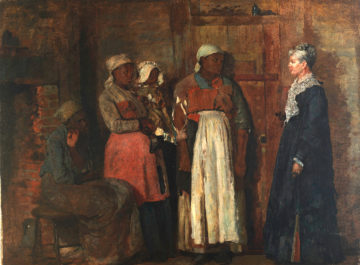Claudia Roth Pierpont at The New Yorker:
 The linchpin of the Met’s show, “The Gulf Stream” intensifies the artist’s racial focus even as it universalizes its sailor’s plight. A single Black man, the drama’s protagonist, is shown bare-chested and casually majestic—“modelled with a musculature and physical power,” Alain Locke wrote in 1936, that “broke the cotton-patch and back-porch tradition” and “began the artistic emancipation of the Negro subject.” But his innate power is to no avail. He lies across the deck of a devastated boat, as gape-mouthed sharks close in; the water nearby is flecked with blood. A few stalks of sugarcane coil across the deck, either a plain fact of his cargo or a sign of centuries of slave trade. “I regret very much that I have painted a picture that requires any description,” Homer replied with typical asperity to questions about its meaning. He also mentioned, though, the influence of Turner’s painting “Slave Ship” (originally titled “Slavers Throwing Overboard the Dead and Dying—Typhoon Coming On”), which Ruskin had once owned but said he found too painful to keep.
The linchpin of the Met’s show, “The Gulf Stream” intensifies the artist’s racial focus even as it universalizes its sailor’s plight. A single Black man, the drama’s protagonist, is shown bare-chested and casually majestic—“modelled with a musculature and physical power,” Alain Locke wrote in 1936, that “broke the cotton-patch and back-porch tradition” and “began the artistic emancipation of the Negro subject.” But his innate power is to no avail. He lies across the deck of a devastated boat, as gape-mouthed sharks close in; the water nearby is flecked with blood. A few stalks of sugarcane coil across the deck, either a plain fact of his cargo or a sign of centuries of slave trade. “I regret very much that I have painted a picture that requires any description,” Homer replied with typical asperity to questions about its meaning. He also mentioned, though, the influence of Turner’s painting “Slave Ship” (originally titled “Slavers Throwing Overboard the Dead and Dying—Typhoon Coming On”), which Ruskin had once owned but said he found too painful to keep.
more here.
